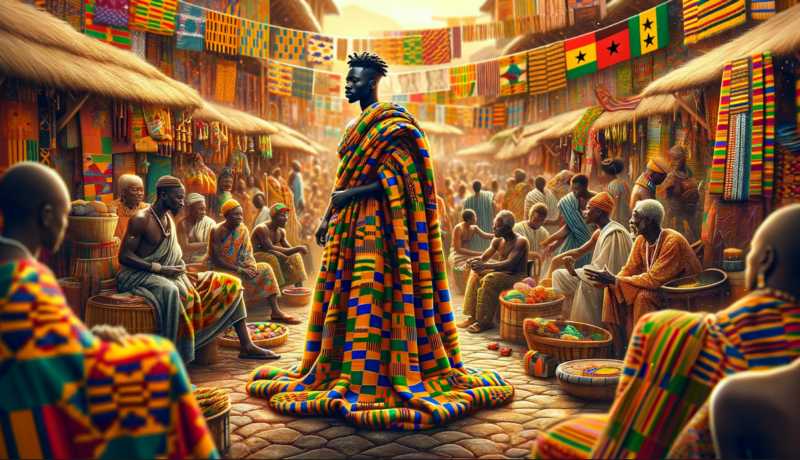Kente Cloth's Cultural Weave: Traditional Ghanaian Fashion

Lost in a World of Vivid Stripes and Geometric Patterns: The Wonders of Kente Cloth
Picture this: a kaleidoscope of vivacious colors and patterns, each with its own story, blended together in perfect harmony to create a cultural tapestry that transcends the boundaries of time and tradition. Behold! The Kente cloth, in all its woven glory, has been a cornerstone of Ghanaian fashion since time immemorial, and today we shall embark on a perilous journey into the heart of its intricate design.Of Kings and Kente: Royalty and Fashion Unite
The Kente cloth has been woven into the fabric of society (pun intended) since its inception. Its origins lie in the mysterious Ashanti kingdom, where legend has it that two farmers, Krugu Amoaya and Watah Kraban, chanced upon a spider weaving its web. They were so mesmerized by the spider's skill and flair that they decided to pay homage to this eight-legged wonder by mimicking its technique in their own looms. Thus, the Kente cloth was born!Now, many a pretentious scholar may argue that the Kente cloth's origins are rooted in the ancient Akan and Ewe weaving traditions, but we must ask ourselves: where's the fun in that?
Regardless of its true origins, the Kente cloth's vibrant display of colors and patterns has long been reserved for royalty, with each piece a dazzling display of the wearer's prestige, power, and status. Its intricately woven threads have adorned the noble shoulders of kings and queens, as they held court and feasted on the spoils of their conquests.
Fear not, for the common folk too have embraced the Kente cloth, incorporating its resplendent patterns into their everyday garb and turning mundane tasks into a celebration of culture and fashion.
Color Me Kente: The Significance of Hues and Patterns
One cannot simply dive headfirst into the world of Kente cloth without a proper introduction to its vast array of colors and patterns. You see, each hue and design carries with it a distinct meaning that has been passed down through generations, weaving a tale as rich and colorful as the cloth itself.- Yellow, the color of royalty, wealth, and vitality, is often seen gracing the attire of kings and queens. It is also said to represent the life-giving power of the sun.
- Blue, signifying peace, harmony, and love, is often found in the clothing of spiritual leaders and healers. Its calming presence is said to bring tranquility to even the most troubled soul.
- Green, the color of life, growth, and renewal, is a favorite among farmers and those seeking a fresh start in life. This verdant hue is said to foster hope and resilience.
- Red, symbolizing passion, sacrifice, and danger, is often worn by warriors and those seeking to make a bold statement. This fiery hue is a testament to the wearer's indomitable spirit.
Kente Today: A Modern Twist on a Timeless Classic
As the world shrinks and cultures collide, the Kente cloth has not been left behind. It has gracefully glided into the modern age, its striking patterns and rich history captured in everything from formal wear to casual attire and even home décor.Fashion-forward individuals have embraced the Kente cloth's unique blend of tradition and style, incorporating its vivid patterns into their wardrobes with gusto. Celebrities and fashion icons alike have been spotted donning Kente-inspired outfits, turning heads and igniting conversations about the cloth's cultural significance.
But it's not just the fashion world that has fallen under the Kente spell. Interior designers and homeowners have also found inspiration in its bold patterns and colors, using it to create eye-catching accent pieces and striking wall art.
So, What's Next for the Kente Cloth?
As the Kente cloth continues to weave its way into the hearts and minds of a global audience, we can only wonder what the future holds for this cultural icon. Will it continue to evolve and adapt to modern tastes, or will it remain an enduring symbol of Ghanaian tradition and heritage?One thing is certain: the Kente cloth's unique blend of history, artistry, and style ensures that it will never fade into obscurity. Its vibrant patterns and colors will continue to captivate and inspire, weaving a tale that spans generations and transcends borders.
So go forth, dear adventurer, and explore the world of Kente cloth with newfound appreciation and enthusiasm. And who knows? You may just find yourself ensnared in its intricate web of cultural splendor.
Article kindly provided by foreverinfashion.org
Latest Articles
- Style That Works With Your Body, Not Against It
- Fashion Tourism on Wheels: Curated Shopping Routes Led by Chauffeur Guides
- The Charm of Certainty in a World of Indecision
- Can an Everyday T-Shirt Be Turned into a Modern Heirloom?
- Color, Ceremony, and the Psychology of Celebration
- Styling Graphic T-Shirts for Different Body Types
- Getting Kids to Wear Their Hats Without a Bribe or a Meltdown
- Mastering the Art of Being the Unnoticed Photographer
- Quiet Sportswear Moves Loudly
- Fashion's Most Misunderstood Color Is Brown
- Weight Matters When Cotton Gets Real
- SKU's Out for Summer: Why Your Warehouse Is Melting Down
- Ink as Accessory - How Tattoos Are Replacing Jewelry in Modern Style
- Decoding the Y2K Aesthetic with Style and Sanity
- Accessories
- Jewellery
- Footwear
- Skirts and Dresses
- Shirts and Blouses
- Beauty and Makeup
- Fashion Photography
- Sustainable Fashion
- Street Style
- Fashion History
- Fashion Business
- Fashion Styling
- Fashion Events
- Plus-Size Fashion
- Men's Fashion
- Women's Fashion
- Fashion Blogging
- Fashion Trends
- Fashion Retailers
- Fashion Tips and Advice
- Fashion Business Startups
- Fashion Around the World
- Lingerie
- Sportswear
- Weddings

